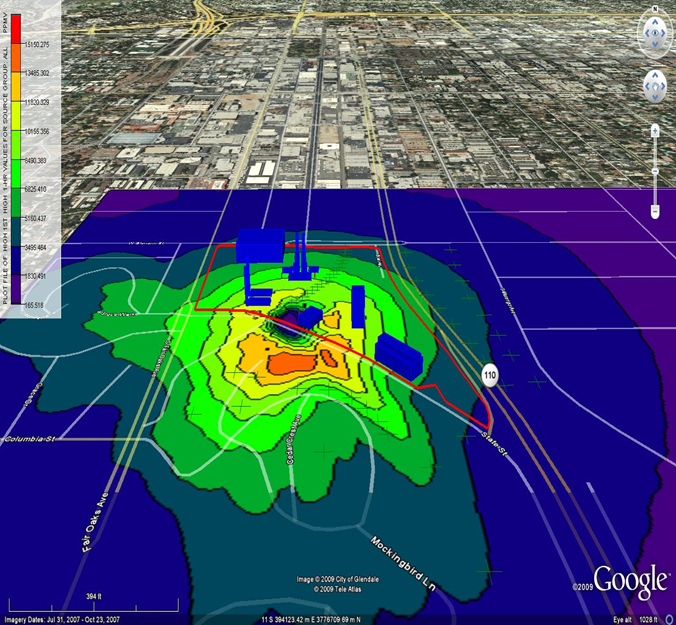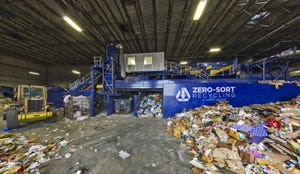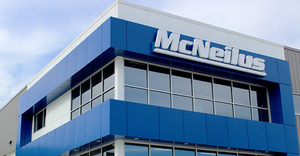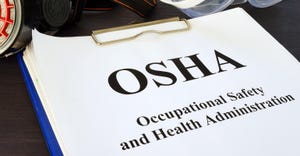Landfill Odors: Why They Happen and Chasing Them Down (Part 2)

Landfill odor is a hot button in the industry. When something smells in encroaching communities, residents typically immediately suspect the neighbor they send their trash to as the responsible party. Much time and money has been spent trying to avoid odor complaints; working to figure out the source if odor happens anyway and trying to resolve the problem when determined that the landfill does indeed own it. There’s a lot to understand in areas from chemistry, to meteorology, to what it takes to become a scrupulous investigator. This three-part series touches on some key areas:
Part 1 examines odor origin, best practices to mitigate, and ideally to altogether circumvent; odor; looking at real-life scenarios.
Part 2 explores investigative tools to determine how odors move offsite, from tools as simple as windsocks to some pretty powerful and sophisticated technologies.
Part 3 tells the story of a company that developed a product to destroy odors rather than neutralize or mask them. But its work was not done once it figured out the formulas; and we tell the rest of the story of what had to happen to make them effective.
This article includes insight from SCS Senior Vice President Pat Sullivan on investigative tools to determine how landfill odors move offsite.
Waste360: What are meteorological studies and what applications do they have?
Pat Sullivan: Meteorological studies are used to gather information on if and how odors move offsite. They examine conditions like wind or temperatures that may cause this movement.
In considering these meteorological conditions, operators must recognize that landfills create their own topography. Many are giant hills that continually grow. Some are canyon areas that you fill in, and both of these layouts can create their own unique wind conditions. Once wind hits the landfill, it can move differently across the site and different in terms of where it goes, and it may have an unexpected impact offsite. So, you have to understand this micrometeorology that exists at your landfill, in addition to regional meteorology.
Another consideration is that winds change throughout the day and seasonally, so you may need to break down wind conditions relative to specific periods, whether portions of day or seasons.
There are uncomplicated to slightly more advanced meteorological tools to help determine wind conditions at your facility and how they can carry odors offsite.
Something as simple as windsocks in strategic locations can give a basic understanding of wind direction and range of magnitude of speed to learn where wind is on your site and during what time of day. Windsocks are the simplest and cheapest way to know how wind moves across a landfill. They can be effective if you know that you get odor complaints during certain wind conditions. They can determine when and where on the landfill those conditions exist. But they do not allow operators to download and manipulate real-time data for study, and do not give exact wind speeds and directions.
The next tool up as far as level of sophistication is onsite meteorological stations, which vary in type and cost. Stations can be used to, at the minimum, provide information on wind speed and direction; but they can also measure temperature, rainfall, humidity, barometric pressure and cloud cover. While winds are especially important, parameters like temperature, rainfall, pressure, and humidity can tell something about how meteorological conditions affect odor. For example, rainfall can reduce odors by “cleaning” contaminants from the air, but the meteorological conditions that come before or after a storm, such as a low-pressure system, could create atypical conditions, which could affect odors.
To capture all the meteorological conditions, you may want multiple stations around your site or portable stations that can move with your operations, so you know in real-time the wind conditions at key locations. These stations can collect data over time to identify trends.
Stations can be set up with wireless connections and provide automatic data downloads that can be viewed in real-time on devices. Programs allow operators to manipulate, graph, and trend that data. So, it’s easier access to data, with the ability to compile and manipulate the data, as well as to get alerts to real-time conditions that can be problematic.

Waste360: Can you provide a hypothetical odor complaint scenario and show how meteorological tools helped?
Pat Sullivan: Let’s say that in certain locations in the community there are complaints only in the morning. You want to figure out why and what role meteorologic conditions play, so you would do an analysis to figure out if there is something unique in the morning winds that is worsening these odors. Is it wind direction? Is it wind speed? Higher winds can actually create dispersion and dilute the concentrations of odorous chemicals in the air, but other times, higher winds can push odors into neighborhoods where they would not normally reach. What were the temperatures in the morning? On that particular morning, was there a heatwave that is not normal during that time? Were there barometric pressure changes when a storm came in? Having answers to these questions through analysis of meteorological conditions can yield valuable information as to the cause of the odors moving offsite, as well as where/how best to control those odors.
Now I will provide a real-life scenario where we were able to explain how and why odors were traveling offsite when it didn’t seem likely that this could happen. We were working on a landfill that just started filling in a new canyon.
The main winds across the site traveled from the southwest, and the neighborhood with odor complaints was to the northwest. Normally, southwest winds would move air to the northeast. But when winds hit the bottom of a canyon, they funneled to the northwest and went into the neighborhood. So, you have different wind conditions in the canyon, and we discovered those winds were causing impacts. This is an example of specific topographic conditions on a landfill that contributed to odors, by creating unique onsite wind conditions. Now they know from real-time data they have to put in odor control rather than just rely on avoiding trash disposal during certain times, as we discovered those problematic winds were predominant during most of the working day and funneled up the canyon.
Waste360: What are some useful data plotting techniques?
Pat Sullivan: One plotting technique is called a wind rose, which is a graphic tool that gives a concise view of wind speed and direction at a particular location of a meteorological station during specific times.
However, wind roses do not automatically tell exactly when during the day the wind behavior occurred. But if you plot data as a wind graph, you know when winds occurred and when they changed. Wind graphs show a change in wind speed and direction during the day, as both are plotted against time of day.
Wind roses look at the prevalence of specific wind directions or speeds during whatever time period is being analyzed. Wind graphs look at the average wind speed and direction during each time of day during the study period.
Waste360: Do landfills typically buy their own wind stations, and what are associated costs?
Pat Sullivan: Cost depends on how many stations and how much you want to break down the data. Landfill operators can buy or rent wind stations that can run ten to twenty thousand dollars for a permanent station with a higher level of sophistication. Temporary stations or stations with lower sophistication may cost five to ten thousand per station. Each station has ongoing operations and maintenance costs as well. Rental costs can also vary from several hundred dollars to up to a thousand dollars per month.
You may need more than one. So many operators own a main station and rent additional ones as needed. They also usually hire an expert to evaluate and interpret the data, although the software that comes with the stations will usually allow the creation of wind roses and other basic data review.
Waste360: What are some more sophisticated techniques beyond simply collecting and evaluating meteorological data?
Pat Sullivan: There is one technique called a smoke study. A smoke “bomb” is released from a source location or area where you think winds are escaping the site. You can record that release with a handheld video camera on the ground or with a camera on drones from above.
You would want to know meteorological conditions at a nearby station in terms of wind speed and direction and release smoke bombs when the conditions you are concerned about are happening. You use the movement of the smoke plume to determine its path out of the landfill to the area you are concerned about and to determine how it settles there.
Smoke studies are especially helpful in determining how odor is getting offsite. It answers questions like, does it follow a unique pathway and once it’s there is it dispersing, or is it settling to a lower area and concentrating there? This may help on the mitigation side as well by illuminating why only certain neighbors are complaining. It may also tell you exactly where along the facility’s perimeter the plume appears to be leaving the site, so you can focus mitigation efforts there.
Waste360: What are tracer studies? What can they do that smoke studies can’t?
Pat Sullivan: With tracer studies, you release a known tracer chemical that is nonreactive and easily detectable.
You would release a different tracer chemical for each location (or source area) and set up sampling stations along the perimeter and in the neighborhood to detect that tracer. You would take many samples over time at different locations and analyze them for concentrations and how those concentrations change over time.
This can tell you how odors may move from onsite to offsite as well as the magnitude of that impact. And it can tell you what area on the landfill is more problematic by comparing the relative impact of each tracer release location. It provides more quantitative information than a smoke study does, but it’s more expensive and, unlike a smoke study, operators can’t do these studies themselves.
Tracer studies are for more complex situations. They can potentially tell whether the odor is coming from the active face or another source area onsite. They are especially instrumental at large landfills with large active faces, gas collection systems, or that may have compost facilities; any one of which can be an odor source. Tracer studies can help determine which is the primary source of odor, as well as approximately the expected magnitude of the odor impact.
Waste360: I understand a model called air dispersion is even more advanced than a tracer. What can air dispersion do that takes it to the next tier of an investigative tool?
Pat Sullivan: Air dispersion modeling, like tracer studies, also assesses how odor emissions can move from onsite to offsite. But tracer studies can only determine relative impact because tracer is not the real chemical causing the odor; it is a surrogate.
The air dispersion model, depending on what information you start with, predicts actual concentration of actual chemical(s) that are potentially causing odor impacts.
The way it works is you plug in onsite meteorological data, as well as receptor locations, elevations, and size and types of source such as landfill gas flare or landfill surface. After you set this data up in the model, you input emission rate data; then the model can predict, for instance, where there will be impact if an odor-causing chemical is released from a given location. And it can predict the concentration of odorous chemicals at a specific receptor location.
You can plug in a default emission rate to tell if the odor can get to a certain location offsite and, if it can, whether the amount of odor-causing chemical is likely great enough to have an impact. This would be more of a screening analysis to assess the relative impacts of chemicals, which is similar to the tracer study.
But if you already know, or have estimated the emission rates, you can determine even more—namely the actual concentration at that receptor location. And you can compare that concentration to odor thresholds that exist for chemicals that you are concerned about.
Waste360: What if you do not know which chemical is causing the odor? How can the air dispersion tool help in this situation?
Pat Sullivan: Sometimes there will be a mixture of chemicals causing odor, and you do not know which one is the driver. In this case, you can use the air dispersion modeling tool to analyze and quantify emission rates for odor units, which is a collective number quantifying the total odor level of that mixture. With the odor unit concept, you can’t tell which chemical or chemicals in the mix is driving the problem. But it’s useful when it’s hard to pinpoint the individual chemical or chemicals that are the cause. By plugging-in an emission rate in odor units, the model can predict offsite concentrations in units. These rates can be compared to regulatory or other published thresholds for odor units.
So, with dispersion models when you know the actual emission rate of the actual chemical you get more information. When you run the model and get a concentration at two or more receptor locations, the model can predict exactly what people are exposed to at each location. And you get real concentrations of the actual chemical or odor units at these locations. Then you can compare concentrations to regulatory or other published thresholds, which can determine whether you have a potential problem with odor impact.
Waste360: In summary what are the main takeaways on each investigative tool you described?
Pat Sullivan: Air dispersion models and tracer studies both are on the more sophisticated end for evaluating how, where, and to what degree odorous chemicals move offsite, where meteorological data reviews and smoke studies are lower-end technologies to determine how odors are moving off-site. But they are all investigative tools for odor investigation, and in certain instances, you may need more than one of them to get the information needed to solve the odor problem.
For tracer and air dispersion models, operators would hire consultants and at a high cost. So, an operator would not rely on them unless they have a crucial situation such as if they are facing litigation or an enforcement action.
It is always best to start simple and conduct screening-level analyses to see if this provides necessary information. The level of sophistication of the analysis can be adjusted based on the complexity of the situation and/or the level of scrutiny the landfill is experiencing.
About the Author
You May Also Like




